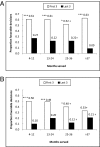Extraneous factors in judicial decisions
- PMID: 21482790
- PMCID: PMC3084045
- DOI: 10.1073/pnas.1018033108
Extraneous factors in judicial decisions
Abstract
Are judicial rulings based solely on laws and facts? Legal formalism holds that judges apply legal reasons to the facts of a case in a rational, mechanical, and deliberative manner. In contrast, legal realists argue that the rational application of legal reasons does not sufficiently explain the decisions of judges and that psychological, political, and social factors influence judicial rulings. We test the common caricature of realism that justice is "what the judge ate for breakfast" in sequential parole decisions made by experienced judges. We record the judges' two daily food breaks, which result in segmenting the deliberations of the day into three distinct "decision sessions." We find that the percentage of favorable rulings drops gradually from ≈ 65% to nearly zero within each decision session and returns abruptly to ≈ 65% after a break. Our findings suggest that judicial rulings can be swayed by extraneous variables that should have no bearing on legal decisions.
Conflict of interest statement
The authors declare no conflict of interest.
Figures



Comment in
-
Overlooked factors in the analysis of parole decisions.Proc Natl Acad Sci U S A. 2011 Oct 18;108(42):E833; author reply E834. doi: 10.1073/pnas.1110910108. Epub 2011 Oct 10. Proc Natl Acad Sci U S A. 2011. PMID: 21987788 Free PMC article. No abstract available.
Similar articles
-
Judicial breakfast as an external factor in judicial decision making in courts.F1000Res. 2023 Jan 4;12:9. doi: 10.12688/f1000research.126482.1. eCollection 2023. F1000Res. 2023. PMID: 36911239 Free PMC article.
-
Tobacco industry use of judicial seminars to influence rulings in products liability litigation.Tob Control. 2006 Apr;15(2):120-4. doi: 10.1136/tc.2005.013128. Tob Control. 2006. PMID: 16565460 Free PMC article. Review.
-
A judicial rashomon: on ageism and narrative justice.J Cross Cult Gerontol. 2012 Mar;27(1):17-28. doi: 10.1007/s10823-012-9160-7. J Cross Cult Gerontol. 2012. PMID: 22246391
-
Courts as communicators: can doctors learn from judges' decisions?J Bioeth Inq. 2004;1(1):49-56. doi: 10.1007/BF02448907. J Bioeth Inq. 2004. PMID: 16025599
-
Baseball bats and chocolate chip cookies: the judicial treatment of DNA in the myriad genetics litigation.Cold Spring Harb Perspect Med. 2014 Dec 18;5(6):a020883. doi: 10.1101/cshperspect.a020883. Cold Spring Harb Perspect Med. 2014. PMID: 25524722 Free PMC article. Review.
Cited by
-
The effect of decision fatigue on surgeons' clinical decision making.Health Econ. 2019 Oct;28(10):1194-1203. doi: 10.1002/hec.3933. Epub 2019 Jul 25. Health Econ. 2019. PMID: 31344303 Free PMC article.
-
The challenge of cognitive science for medical diagnosis.Cogn Res Princ Implic. 2023 Feb 9;8(1):13. doi: 10.1186/s41235-022-00460-z. Cogn Res Princ Implic. 2023. PMID: 36759370 Free PMC article.
-
Overlooked factors in the analysis of parole decisions.Proc Natl Acad Sci U S A. 2011 Oct 18;108(42):E833; author reply E834. doi: 10.1073/pnas.1110910108. Epub 2011 Oct 10. Proc Natl Acad Sci U S A. 2011. PMID: 21987788 Free PMC article. No abstract available.
-
Time on shift in the emergency department and decision to prescribe opioids to patients without chronic opioid use.Clin Exp Emerg Med. 2022 Jun;9(2):108-113. doi: 10.15441/ceem.22.212. Epub 2022 Jun 30. Clin Exp Emerg Med. 2022. PMID: 35843610 Free PMC article.
-
Does the "Morning Morality Effect" Apply to Prehospital Anaesthesiologists? An Investigation into Diurnal Changes in Ethical Behaviour.Healthcare (Basel). 2020 Apr 16;8(2):101. doi: 10.3390/healthcare8020101. Healthcare (Basel). 2020. PMID: 32316371 Free PMC article.
References
-
- Leiter B. In: The Blackwell Guide to Philosophy of Law and Legal Theory. Edmundson W, Golding M, editors. Oxford: Blackwell; 2005. pp. 50–66.
-
- Neuborne B. Of sausage factories and syllogism machines: Formalism, realism and exclusionary selection techniques. NYU L Rev. 1992;67:419–449.
-
- Holmes OW. The Common Law. Boston: Little, Brown; 1881.
-
- Frank J. Law and the Modern Mind. New York: Brentano's; 1930.
-
- Kozinski A. What I ate for breakfast and other mysteries of judicial decision making. Loyola LA L Rev. 1993;26:993.
MeSH terms
LinkOut - more resources
Full Text Sources
Research Materials

